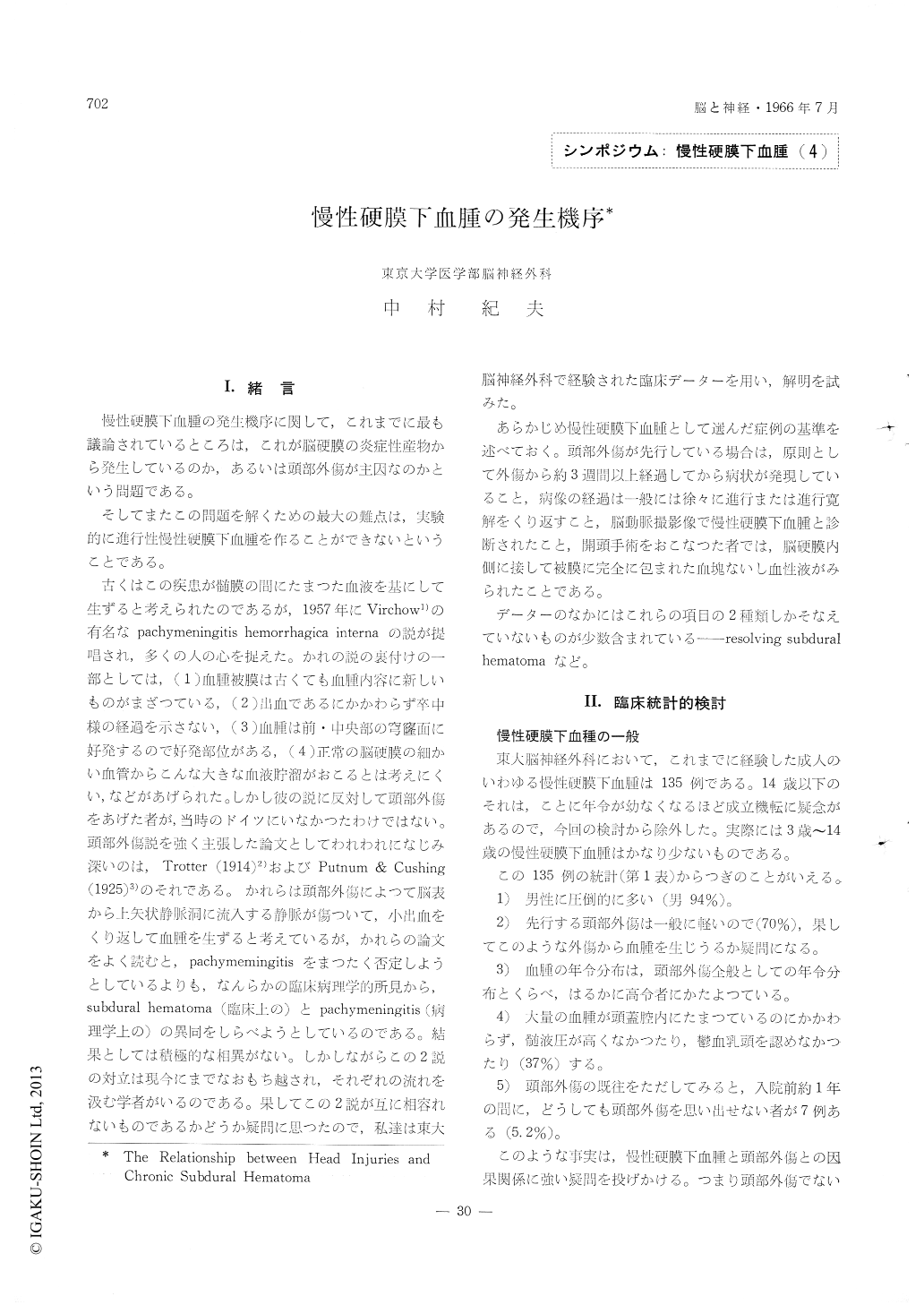Japanese
English
- 有料閲覧
- Abstract 文献概要
- 1ページ目 Look Inside
I.緒言
慢性硬膜下血腫の発生機序に関して,これまでに最も議諭されているところは,これが脳硬膜の炎症性産物から発生しているのか,あるいは頭部外傷が主因なのかという問題である。
そしてまたこの問題を解くための最大の難点は,実験的に進行性慢性硬膜下血腫を作ることができないということである。
During the last 15 years, 135 cases of chronic sub-dural hematoma in adults over 15 years of age were admitted to the neurosurgical department of the University of Tokyo Hospital.
Over 91% of the total had suffered from head in-juries in the year prior to the admission. Therefore, to find the relationship between head injuries and chronic subdural hematoma, clinical investigation was conducted on the histological aspects of subdural hematoma in general.
In the case of severe head injuries followed by acute subdural hematoma, some fibroblasts were found to have infiltrated the clots located adjacent to the inner side of the dura mater, sometimes within 9 hours of the injury.
On the 11th post-operative day, a thin granulation layer, composed of loose connective tissure rich in vessels with thin walls, had already been produced just beneath the dura, which is called the sinusoidal channel layer.
On the 20th post-traumatic day, the sinusoidal chan-nel layer extended a sheet of the fibrous tissue over the edge of subdural clot and between the latter and the brain matter, enveloping the hematoma.
In chronic cases of subdural hematoma, the appear-ance of the outer membrane was very similar to the above-mentioned sinusoidal channel layer seen in acute cases. Moreover, the thickness of the fibrous layer inside the sinusoidal channel layer was found to be directly proportional to the duration of time interval between the head injury and the operation
In the case of a 10-month-old subdural hematoma, almost all of the outer membrane was composed of the fibrous layer, and vascular channels were found to be poorly developed on the dural side of the outer membrane. In one of chronic subdural hematomas, instead of total removal, intra-capsular drainage and irrigation was done, leaving the membrane intact. The same patient died by accident 6 months later and autopsy revealed that the subdural membrane was found to have calcified already.
Similar reaction of the dura mater to blood clot was produced in extradural clot or chronic extradural hema-toma. Furthermore, the same process was found around a sheet of artificial fibrin film, inserted under the dura mater in man.
Apart from these observations, in chronic subdural hematoma, the gross appearance as well as the histo-logical study of the inner membrane revealed that the outer membrane extended itself over the edge of the hematoma and overlapped a part of the inner mem-brane at its edge.
Next, the question arises about the origin of sub-dural bleeding in chronic cases. The author has ex-perienced over 15 cases of ruptured parasagittal bridg-ing veins into the subdural space following mild head injuries. In these cases, accumlation of blood clot took place in the subdural space around the ruptured vein, and clinical manifestations were acute.
From these investigations, it is possible to assume the following mechanisms on the production of chronic subdural hematoma : a mild head injury damages a bridging vein from which blood oozes out into the subdural space, followed by a reactive proliferation from the dura mater which gradually covers the blood clot and finally envelopes it.
On the other hand, it is well known from clinical observations as well as animal experiments that blood clot in the subdural space can be easily absorbed and resolved commonly and does not produce long-term progressive changes. Furthermore, clinical survey in this department shows that chronic subdural hematoma affects or was encountered predominantly in males and older people. And 9% of the patients did not re-member any head injury prior to their admission.
To comprehend the histological survey and the clinical observations simultaneously, the author would like to advocate another supplementary factor "a" in addition to head injury as one of the etiological mechanisms of chronic subdural hematoma.
When a subdural blood clot, resulting from an in-jury of the head, is accompanied by the factor "a", it may be enveloped by a proliferative reaction from the dura mater in the course of time and subsequently chronic subdural hematoma ensues. However, neither head injury nor the factor "a" , singly produces chronic subdural hematoma. This factor "a" might be a combination of various dispositions, including intra-cranial hypotension, cerebrovascular diseases, pachy-meningitis interna and so on. The author is planning to undertake an investigation on this factor "a" as the next maior problem.

Copyright © 1966, Igaku-Shoin Ltd. All rights reserved.


